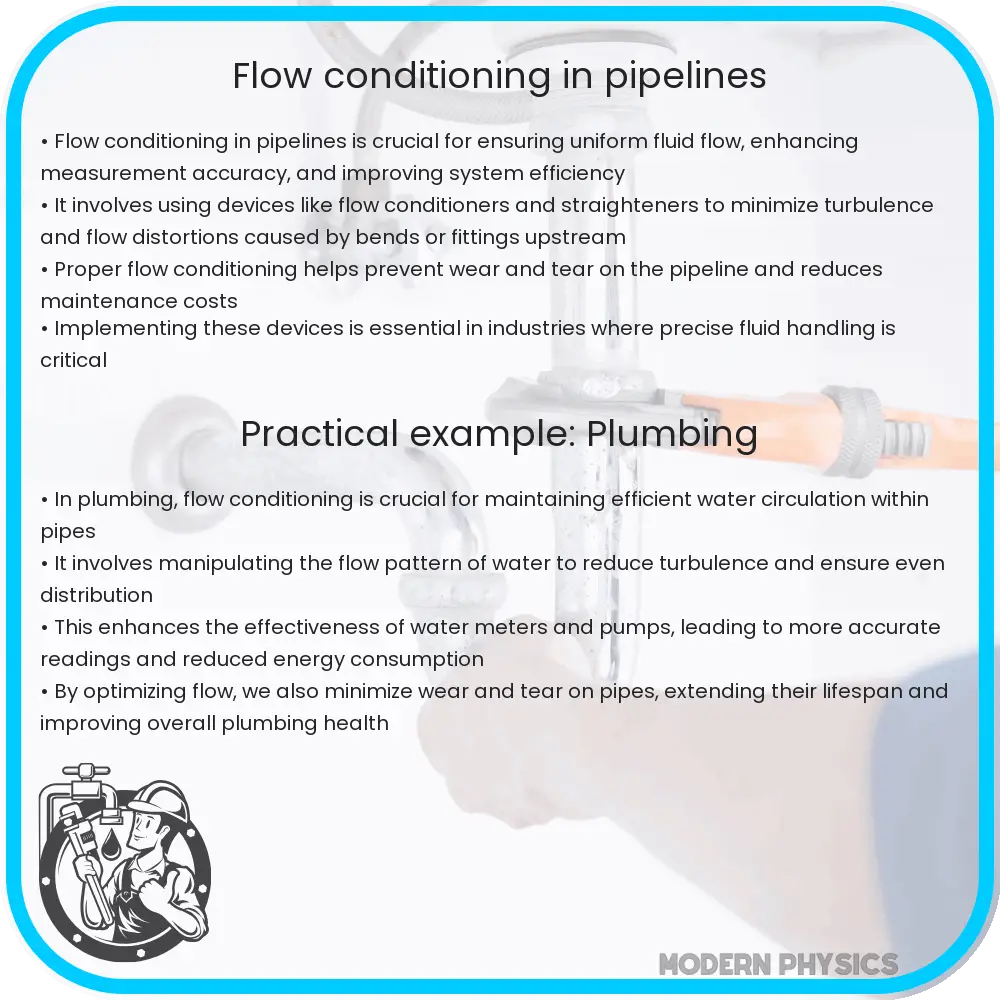Explore the essentials of flow conditioning in pipelines for enhanced efficiency, stability, and precision in fluid mechanics across industries.

Understanding Flow Conditioning in Pipelines
Flow conditioning is a pivotal concept in fluid mechanics, particularly in pipeline systems. It involves the use of specific techniques to ensure a stable, efficient, and precise control of fluid flow. This article explores the fundamentals of flow conditioning, its significance, and the benefits it offers in various industrial applications.
Key Principles of Flow Conditioning
Flow conditioning primarily revolves around three core principles: Efficiency, Stability, and Precision. These principles are essential in managing the dynamics of fluid flow within pipelines.
- Efficiency: Efficient flow conditioning reduces energy consumption and minimizes losses due to friction and turbulence. This is achieved through the optimization of pipeline design and the implementation of flow conditioners that streamline fluid movement.
- Stability: Stable flow conditions are crucial for preventing fluctuations and pulsations in pressure and velocity. This stability is vital for systems that require consistent flow characteristics for accurate measurements and control.
- Precision: Precise control of fluid flow is necessary for applications that demand exact delivery rates or specific flow patterns. Precision in flow conditioning is achieved through advanced control systems and finely-tuned flow conditioners.
Flow Conditioning Techniques
Various techniques are employed to condition flow within pipelines. Some of these include:
- Flow Straighteners: These are used to align fluid particles in a parallel manner, reducing turbulence and ensuring a laminar flow.
- Pressure Regulators: These devices help in maintaining a constant pressure within the pipeline, irrespective of external fluctuations.
- Vortex Generators: These are used to create a controlled swirl in the flow, which can enhance mixing or heat transfer.
Implementing these techniques in pipeline systems not only enhances the efficiency but also contributes to the longevity and reliability of the system. The selection of appropriate flow conditioning methods depends on various factors, including the type of fluid, flow rate, temperature, and the specific requirements of the application.
Application in Various Industries
Flow conditioning is integral in many industries, including:
- Petroleum and Gas: In these industries, flow conditioning is critical for accurate measurement of fluid quantities and for ensuring the safe transport of fluids.
- Chemical Processing: Precise flow control is essential for maintaining the correct proportions of reactants and for efficient heat transfer.
- Water Treatment: Here, flow conditioning is used for effective sedimentation and filtration processes.
Understanding the principles and techniques of flow conditioning can significantly impact the efficiency, stability, and precision of fluid flow in pipelines, thereby playing a crucial role in the operational success of various industrial processes.
Advanced Flow Conditioning Technologies
Recent advancements in flow conditioning technologies have further enhanced their effectiveness. Innovations such as computational fluid dynamics (CFD) modeling allow for precise simulation and optimization of flow conditions in pipelines. Smart flow conditioners, equipped with sensors and automated controls, can dynamically adjust to changing flow characteristics, offering unprecedented control and efficiency.
Challenges and Solutions in Flow Conditioning
Despite its benefits, flow conditioning faces several challenges. One of the primary concerns is the scaling and corrosion inside pipelines, which can alter flow characteristics. To combat this, anti-corrosion coatings and regular maintenance routines are essential. Another challenge is the handling of multiphase flows, where different states of matter coexist, such as in oil and gas pipelines. Advanced multiphase flow conditioners and separators are used to address this issue.
Environmental Considerations
Environmental sustainability is a growing concern in industrial processes, and flow conditioning plays a vital role here. Efficient flow management reduces energy consumption and minimizes environmental impact. By optimizing flow conditions, industries can achieve lower carbon footprints and contribute to sustainable operations.
Future of Flow Conditioning
The future of flow conditioning looks promising with ongoing research and technological developments. Emerging technologies like artificial intelligence and IoT (Internet of Things) are set to revolutionize flow conditioning by enabling more predictive and adaptive systems. These advancements will ensure higher efficiency, precision, and sustainability in fluid mechanics.
Conclusion
In conclusion, flow conditioning is an essential aspect of fluid mechanics that ensures efficiency, stability, and precision in pipeline systems. With its wide range of applications across various industries, the importance of flow conditioning cannot be overstated. The integration of advanced technologies and adherence to environmental considerations further enhances its relevance. As industries continue to evolve, the role of flow conditioning in achieving sustainable and efficient operations will undoubtedly become more significant, making it a key area of focus for future innovations and improvements.
